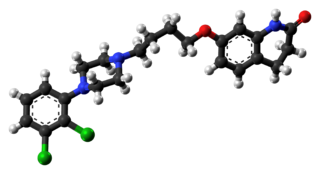
Aripiprazole, sold under the brand names Abilify and Aristada, among others, is an atypical antipsychotic. It is primarily used in the treatment of schizophrenia, bipolar disorder, and irritability associated with autism spectrum disorder; other uses include as an add-on treatment in major depressive disorder and tic disorders. Aripiprazole is taken by mouth or via injection into a muscle. A Cochrane review found low-quality evidence of effectiveness in treating schizophrenia.

Trazodone, sold under many brand names, is an antidepressant medication used to treat major depressive disorder, anxiety disorders, and insomnia. It is a phenylpiperazine compound of the serotonin antagonist and reuptake inhibitor (SARI) class. The medication is taken orally.

Flupentixol (INN), also known as flupenthixol, marketed under brand names such as Depixol and Fluanxol is a typical antipsychotic drug of the thioxanthene class. It was introduced in 1965 by Lundbeck. In addition to single drug preparations, it is also available as flupentixol/melitracen—a combination product containing both melitracen and flupentixol . Flupentixol is not approved for use in the United States. It is, however, approved for use in the UK, Australia, Canada, Russian Federation, South Africa, New Zealand, Philippines, Iran, Germany, and various other countries.
The orexin receptor (also referred to as the hypocretin receptor) is a G-protein-coupled receptor that binds the neuropeptide orexin. There are two variants, OX1 and OX2, each encoded by a different gene (HCRTR1, HCRTR2).

P2X purinoceptor 7 is a protein that in humans is encoded by the P2RX7 gene.

Almorexant (INN), also known by its development code ACT-078573, is an orexin antagonist, acting as a competitive antagonist of the OX1 and OX2 orexin receptors, which was being developed by the pharmaceutical companies Actelion and GSK for the treatment of insomnia. Development of the drug was abandoned in January 2011 due to concerns over the hepatic safety of almorexant after transient increases in liver enzymes were observed in trials.

SB-271046 is a drug which is used in scientific research. It was one of the first selective 5-HT6 receptor antagonists to be discovered, and was found through high-throughput screening of the SmithKline Beecham Compound Bank using cloned 5-HT6 receptors as a target, with an initial lead compound being developed into SB-271046 through a structure-activity relationship (SAR) study. SB-271046 was found to be potent and selective in vitro and had good oral bioavailability in vivo, but had poor penetration across the blood–brain barrier, so further SAR work was then conducted, which led to improved 5-HT6 antagonists such as SB-357,134 and SB-399,885.

Suvorexant, sold under the brand name Belsomra, is an orexin antagonist medication which is used in the treatment of insomnia. It is indicated specifically for the treatment of insomnia characterized by difficulties with sleep onset and/or maintenance in adults. Suvorexant helps with falling asleep faster, sleeping longer, being awake less in the middle of the night, and having better quality of sleep. Its effectiveness is modest, and is similar to that of other orexin antagonists, but is lower than that of benzodiazepines and Z-drugs. Suvorexant is taken by mouth.
An orexin receptor antagonist, or orexin antagonist, is a drug that inhibits the effect of orexin by acting as a receptor antagonist of one (selective orexin receptor antagonist or SORA) or both (dual orexin receptor antagonis or DORA) of the orexin receptors, OX1 and OX2. Medical applications include treatment of sleep disorders such as insomnia.

Aticaprant, also known by its developmental codes JNJ-67953964, CERC-501, and LY-2456302, is a κ-opioid receptor (KOR) antagonist which is under development for the treatment of major depressive disorder. A regulatory application for approval of the medication is expected to be submitted by 2025. Aticaprant is taken by mouth.

Seltorexant, also known by its developmental code names MIN-202 and JNJ-42847922, is an orexin antagonist medication which is under development for the treatment of depression and insomnia. It is a selective antagonist of the orexin OX2 receptor (2-SORA). The medication is taken by mouth.

JNJ-42165279 is a drug developed by Janssen Pharmaceutica which acts as a potent and selective inhibitor of the enzyme fatty acid amide hydrolase (FAAH), with an IC50 of 70 nM. It is described as a covalently binding but slowly reversible selective inhibitor of FAAH. JNJ-42165279 is being developed for the treatment of anxiety disorders and major depressive disorder. Clinical development has progressed as far as Phase II human trials with two studies in patients with mood disorders registered in ClinicalTrials.gov.

JNJ-39393406 is an experimental medication which is under development by Janssen Pharmaceutica, a division of Johnson & Johnson, for the treatment of depressive disorders and smoking withdrawal. It acts as a selective positive allosteric modulator of the α7 nicotinic acetylcholine receptor (nAChR). It does not act on the α4β2 or α3β4 nAChRs or the serotonin 5-HT3 receptor, and does not interact with a panel of 62 other receptors and enzymes. The drug has been found to lower the agonist and nicotine threshold for activation of the α7 nAChR by 10- to 20-fold and to increase the maximum agonist response of the α7 nAChR by 17- to 20-fold.

Daridorexant, sold under the brand name Quviviq, is an orexin antagonist medication which is used for the treatment of insomnia. Daridorexant is taken by mouth.

JNJ-18038683 is a potent and selective antagonist of the 5HT7 serotonin receptor discovered by Johnson & Johnson. It has nootropic and antidepressant effects in both animal and human studies and has progressed to Phase II trials as an adjunctive treatment for improving cognition and mood in stable bipolar disorder; it has been found to reduce REM sleep (the lightest stage of sleep, elevated in depression) in humans and block circadian rhythm phase-shift advances in mice.

Vornorexant, also known by its developmental code names ORN-0829 and TS-142, is an orexin antagonist medication which is under development for the treatment of insomnia and sleep apnea. It is a dual orexin OX1 and OX2 receptor antagonist (DORA). The medication is taken by mouth. As of June 2021, vornorexant is in phase 2 clinical trials for insomnia and phase 1 trials for sleep apnea. It is under development by Taisho Pharmaceutical.

Tebideutorexant (developmental code names JNJ-61393215, JNJ-3215) is an orexin antagonist medication which is under development for the treatment of depression and anxiety disorders. It is an orally active compound and acts as a selective antagonist of the orexin OX1 receptor (1-SORA). Preliminary clinical findings suggest that tebideutorexant may have anti-panic effects in humans. As of June 2023, tebideutorexant is in phase 2 clinical trials for the treatment of major depressive disorder while no further development has been reported for treatment of panic disorder and other anxiety disorders. The drug was originated and developed by Janssen Pharmaceuticals.

JNJ-55308942 is an investigational drug that works as a P2X7 antagonist with a downstream effect of reducing interleukin-1β release. It is developed by Janssen Pharmaceuticals for bipolar depression.
















